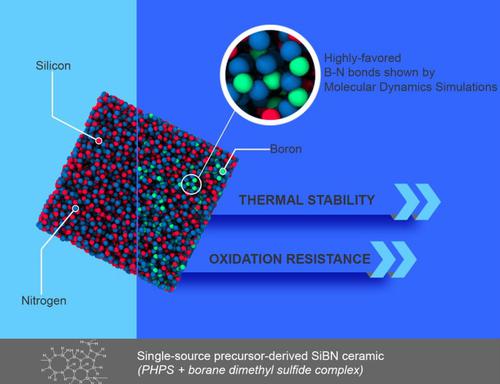Journal of Advanced Ceramics ( IF 18.6 ) Pub Date : 2022-05-28 , DOI: 10.1007/s40145-022-0597-z Ying Zhan , Wei Li , Tianshu Jiang , Claudia Fasel , Emmanuel Ricohermoso , Jan Bernauer , Zhaoju Yu , Zhenghao Wu , Florian Müller-Plathe , Leopoldo Molina-Luna , Ralf Grottenmüller , Ralf Riedel

|
SiBN ceramics are widely considered to be the most promising material for microwave-transparent applications in harsh environments owing to its excellent thermal stability and low dielectric constant. This work focuses on the synthesis and ceramization of single-source precursors for the preparation of SiBN ceramics as well as the investigation of the corresponding microstructural evolution at high temperatures including molecular dynamic simulations. Carbon- and chlorine-free perhydropolysilazanes were reacted with borane dimethyl sulfide complex at different molar ratios to synthesize single-source precursors, which were subsequently pyrolyzed and annealed under N2 atmosphere (without ammonolysis) to prepare SiBN ceramics at 1100, 1200, and 1300 °C with high ceramic yield in contrast to previously widely-used ammonolysis synthesis process. The obtained amorphous SiBN ceramics were shown to have remarkably improved thermal stability and oxidation resistance compared to amorphous silicon nitride. Particularly, the experimental results have been combined with molecular dynamics simulation to further study the amorphous structure of SiBN and the atomic-scale diffusion behavior of Si, B, and N at 1300 °C. Incorporation of boron into the Si—N network is found to suppress the crystallization of the formed amorphous silicon nitride and hence improves its thermal stability in N2 atmosphere.
中文翻译:

硼改性全氢聚硅氮烷可轻松合成具有优异热稳定性的非晶 SiBN 陶瓷
SiBN陶瓷因其优异的热稳定性和低介电常数而被广泛认为是在恶劣环境中用于微波透明应用的最有前途的材料。这项工作的重点是用于制备 SiBN 陶瓷的单源前驱体的合成和陶瓷化,以及研究高温下相应的微观结构演变,包括分子动力学模拟。无碳无氯全氢聚硅氮烷与不同摩尔比的硼烷二甲基硫醚络合物反应合成单源前驱体,随后在 N 2下热解和退火大气(无氨解)在 1100、1200 和 1300 °C 下制备 SiBN 陶瓷,与以前广泛使用的氨解合成工艺相比,陶瓷产率高。与非晶氮化硅相比,得到的非晶 SiBN 陶瓷具有显着提高的热稳定性和抗氧化性。特别是,将实验结果与分子动力学模拟相结合,进一步研究了 SiBN 的非晶结构以及 Si、B 和 N 在 1300 ℃下的原子级扩散行为。发现在Si-N网络中掺入硼可以抑制所形成的非晶氮化硅的结晶,从而提高其在N 2气氛中的热稳定性。


















































 京公网安备 11010802027423号
京公网安备 11010802027423号